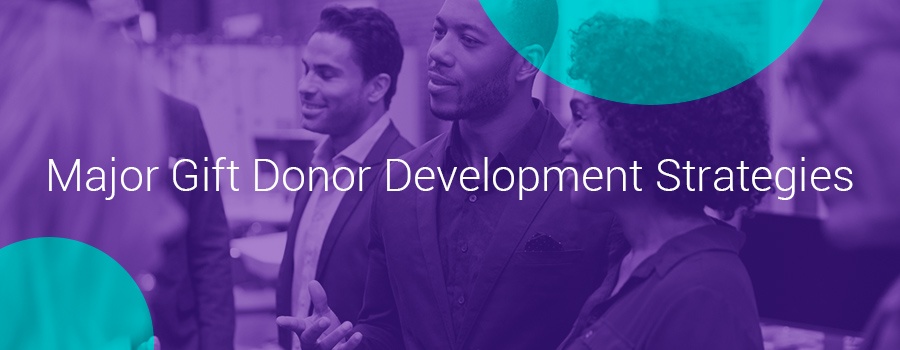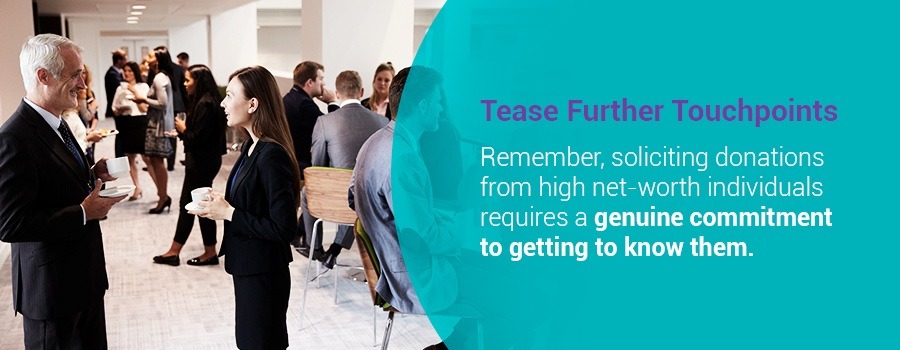Nov 21, 2019
Major Gift Donor Development Strategies

There’s no substitute for the impact of major gifts or the select group of high net-worth donors who provide them.
Today, over 88% of the average nonprofit’s funds come from less than 20% of donors. Whether you realize it or not, that fraction of your donor roll is your major donors — and they require a stewardship and development strategy nurturing their vital contributions.
What is a major gift?
Major gifts for nonprofits are a category of financial donations. More specifically, they are the most significant donations your nonprofit receives throughout its fundraising calendar, and are otherwise known as large-dollar gifts.
Depending on the size, scale and location of your nonprofit, among other factors, the average major gift can fall between $1,000 to well over tens of thousands of dollars for a single donation.
Why do major gifts matter for your organization?
Major gifts are a type of fundraising sourced from individual donors. According to the most recent nationwide data, 68% of all charitable giving comes from individuals — making private donations the leading source of annual charitable giving. Individual giving, totaling $292.09 billion given in 2018 alone, accounts for more than foundations ($75.86 billion), bequests ($39.71 billion) and corporate giving ($20.05 billion) combined.
In short, major gifts from high net-worth donors are the most influential and impactful source of revenue for nonprofits in the United States today. For this reason, your organization must prioritize them. There are three steps in securing these donations: cultivation, solicitation and stewardship.
How to cultivate a major gift donor
Given the significance of major gifts, it’s no surprise fundraising and development officers feel more pressure than ever to focus on principal gift development work and build stewardship pipelines for high net-worth donors.
Does this situation sound familiar? Follow these key steps to supporting a successful major gift donor cultivation strategy.
1. Define what a major gift is for you
The first step in your donor cultivation strategies is outlining a donation or stewardship matrix for your organization. A stewardship matrix displays what donors receive in return for their level of support, as well as where their donations go. For example, a donor who gives $20 a month may receive a T-shirt and a subscription to your e-newsletter, while another donor who pledges $100 a month may receive those items, plus handwritten thank-yous and invites to VIP community events.
Display your donation matrix on your website, using formal, yet warm and inviting, language. Highlighting your donation tiers instills stewardship and donation pitches as a standardized, routine and professional part of your nonprofit operations, not just ad-hoc asks.
2. Identify viable donor prospects
Potential major gift donors are individuals you identify during your major gift prospect research who are the most likely giving candidates. This tier of donors holds the means and the motivation to give major gifts to your organization, namely because:
- They are a friend, family member or colleague of yours, other staff or board members
- They have a connection with your nonprofit’s mission
Most often, nonprofits target high net-worth donors through wealth screening, as well as behavioral and demographic research that creates major gift donor profiles. Wealth screens can help you identify and categorize prospective donors, according to indicators like:
- Past nonprofit/philanthropic activity
- Business affiliations
- Political contributions
- Real estate, stock and other wealth assets
3. Craft major gift campaigns and proposals
Ideally, you have the resources to create a campaign targeting each tier in your donations matrix. These campaigns cover a complete stewardship timeline, borrowing from lead-nurturing marketing tactics to attract and appeal to specific prospective major gift donors and familiarize them with your nonprofit.
- Social media marketing
- Email drips, if you have their email address
- Printed or mailed materials
- Initial phone or email contact
- And more
Integrate these campaigns into your CRM software, or whatever system you use to organize donor touchpoints and communication methods. That way, you have a central repository tracking where a donor sits in the stewardship process, as well as what campaign type or information is filtering their way.
4. Set up meet-and-greets
Early meetings with major donors should be informal and engaging. The goal is to establish a friendly rapport, one paving the way for an ongoing relationship.
From there, stewardship efforts should focus almost exclusively on cultivating a deeper connection. Invite the prospective donor to all nonprofit events. Get them involved through volunteering, pro bono work or even just pick-your-brain coffee sessions. Give them a private tour of your nonprofit with lunch among staff. The more you stay on their radar, the stronger your donor cultivation strategy.
5. Consider hiring a major gifts officer
Major gifts officers (MGOs) specialize in building, managing and growing your fundraising operations. Their career has focused on honing fundamental major gift development skills.
You can choose to appoint an MGO internally, naming a current staff member to spearhead these major gift development initiatives. These specialists can also be part-time or full-time consultants, working at firms with resources available to wealth screen and generate qualified donor leads lists. In either case, the MGO’s expertise can be critical to working smarter — not harder — to secure high-value major gifts.
How to solicit a major gift
Successful stewardship prioritizes the donor. It lets the individual feel valued and in control, never pressured or pestered for the “hard” donation. The result is a generous gift as meaningful to the donor as it is to you.
How can you nurture the kinds of relationships resulting in high-impact fundraising? Follow these steps for authentic individual donor cultivation with your high-value prospects.
1. Start a year in advance
When planning how to ask for a major gift, first put yourself in your prospective donors’ shoes. Cold calls asking for large sums of money are easy to turn down — and would likely turn you off. These kinds of fundraising tactics also feel intensely impersonal. You don’t know what motivates your donor, their background, likes, dislikes and philanthropic interests, and therefore can’t position yourself as a match.
Relationship-building takes time, though. Start conducting major gift prospect research well over a year before any projected donation deadlines. Give yourself months, if not that entire year, to nurture communications and multiple meet-ups with tentative donors. Each touchpoint in your major gift strategy timeline matters — but should never, ever feel rushed.
2. Prepare your “leads” list of current and prospective donors
You’ve done your donor research and vetted potential leads. Now it’s time to pick up that phone and begin contacting high-value prospects.
Be warm, engaging and energetic, but always professional. Most importantly, personalize this inaugural touchpoint as much as possible. For example, if this lead is a business contact of a member of your board, consider sharing an anecdotal story about that mutual contact during your initial call or email.
3. Launch your multi-touchpoint digital campaigns
Consider tailoring nonprofit digital campaigns to target a large swath of your prospective donors, showcasing impactful messages right on their screens, social media feeds and inboxes.
When combined with nonprofit CRM systems, these campaigns deliver meaning and context to your work. They begin to increase familiarity with your nonprofit. Best of all, these materials can be highly instructive, offering objective and anecdotal information behind your nonprofit’s impact on the community.
Use your digital platforms to create and curate campaigns like:
- Social media posts, videos and photo galleries surrounding current initiatives
- Donor spotlights and impact studies
- Annual donor impact reports
- Links to your online donations page
- Testimonials from current high-impact, high-value donors
4. Set up an initial meeting
Your initial meeting should steer clear of any donation talk. The purpose of early meet-and-greets is to get to know your this individual, not talk technicalities.
Reasons for the meeting will vary. Consider the approach you think most persuasive to that particular individual, as well as work with their schedule. You can approach the prospective donor asking to set up time for:
- Advice, input or brainstorming sessions
- Learn more about a donor’s life’s story and the impact they wish to leave
- Shoptalk about their professional background, business interests and network
- And more
5. Tease further touchpoints
Now is where the real donor nurturing begins.
Outline numerous events — at your nonprofit as well as other private and public gatherings — to extend a personal invite to the donor. Also, consider wider events that would allow you to liaise or rub elbows organically with the prospective donor. Remember, soliciting donations from high net-worth individuals requires a genuine commitment to getting to know them. Only time lets you do this.
Create multiple touchpoints and opportunities to interact organically across the calendar year. Be creative, but practical. Use anyone with social capital and influence in your current network to further engage the donor. Invite your prospective donor to any of the following:
- Volunteer opportunities
- Sports fundraisers/tournaments, such as a golf outing
- Family days at your nonprofit — bring the kids, grandkids and spouses!
- Community partnerships
- Galas, dinners, auctions and others
- Lunches or dinners with board members
- Donor appreciation events
6. Make a smaller, non-financial ask
Research shows people like us more when we ask them for small favors. Use the power of the small ask in your major gift donor cultivation strategy. After all, you’ve spent months casually, yet meaningfully, connecting with this donor. Both of you are ready for this next step in developing your relationship.
There are dozens of small, non-money related asks you can make with the donor.
- Write a guest post you’ll publish on your blog
- Share one of your campaigns, videos or fundraiser links on their social media
- Return a feedback survey on your nonprofit’s operations
- Join a committee
- Become a mentor for one of your nonprofit’s target constituents
- Volunteer at an upcoming event
- Give a pro bono speech or keynote address at an upcoming event you’re involved with
7. Schedule the major gift solicitation one year after your first touchpoint
It’s been a year after that first phone call, coffee or lunch with a prospective donor. That’s 12 months of social media campaigns, volunteer requests, event invites, one-on-one meetings and — hopefully — genuine connection. Now is the time to schedule your official fundraising live appeal, one tailored to this individual.
Be transparent about the nature of the event. Depending on the level of financial commitment involved in the gift amount, invite the donor’s spouse or partner to the meeting. Keep your major gift appeal centered on four main points:
- Donation tiers/gift options
- Where exactly donations go
- The impact/intended results of that donation
- How you will prove those results
In addition to these objectives, consider tailoring your pitch to the donor’s likes and interests. If possible, you may even let them determine the nature of their major contribution by asking:
- What is a meaningful philanthropic activity to you? How can we offer it?
- Where exactly would you like your gift to go? Why?
How to steward a major gift donor
Stewardship plans standardize how you prepare, court and ask prospective major gift donors to support your nonprofit. These programs add two final steps to the major gift stewardship process: thanking your donors, and ensuring your partnership doesn’t end after receiving a gift.
1. Nurture ongoing multimedia campaigns
Remember those multimedia campaigns you created as you launched a formal major gift strategy? These materials are pivotal at every stage in the stewardship process, including after a donor’s generosity.
That is because multimedia campaigns drum up attention around your causes and generate a “name-brand” appeal for your nonprofit. It’s impossible to overstate the impact that authoritative presence can make when attracting and maintaining qualified donors, who benefit from seeing the public impact your organization has.
Use your multimedia campaigns to share successes from raised funds across several platforms — many of them free:
- Guest posting on industry-relevant blogs/websites
- Publishing press releases
- Highlighting community case studies
- Releasing volunteer impact reports
- Sharing personal testimonies via video, social media posts, etc.
Remember, multimedia campaigns serve as the foundation for ongoing donation procurement. The more your reputation precedes you, the easier it will be to curate ongoing relationships with high-value donors.
2. Phone your thanks
Pick up the phone and give thanks no longer than 48 hours after you’ve received a donor’s gift.
This turnaround is crucial. Not only does a genuine thanks over the phone relay the professionalism of your nonprofit’s operations, but it also reinforces the value you place in that person’s donation and conveys the personal attention you provide to your donor network.
3. Send a physical token of gratitude
A few days after your thank-you phone call, gift your donor a formal token of thanks along with a handwritten thank-you letter. This step of the stewardship process should focus on a tangible or physical item expressing your gratitude and signifying the importance of your connection.
Remember these best practices for you donor thank-you letters:
- Thank-you letters handwritten by staff, a board or trustee member
- Gift amount stated, as well as the cause it went to or the impact it made
- An actual signature
- A personalized postscript, or a memorable and relational way to sign off on the thank you
4. Invite donor to a special, relevant event
A few weeks after you received a major donation, reach back out to the donor with a special invite to an exclusive event.
Ideally, these events are ones your nonprofit is hosting. You can also share invites to wider gatherings relevant to the donor, including those with area business leaders, entrepreneurs, other nonprofit networks and local politicians. The more attractive these events are to a donor’s likes, interests and personality, the better. Consider:
- Golf outings
- Catered luncheons
- Sponsored happy hours
- Select invites to a special speaker or seminar
- Family day, festivals or carnivals at your nonprofit
- And more
5. Schedule a one-on-one follow-up
Select a time to meet face-to-face with the donor in a relaxed, interpersonal setting. There are two purposes to this rendezvous:
- Receive feedback on their most recent donor experience, looking for ways to improve your stewardship process and amenities.
- Hear in detail what a meaningful contribution looks like to them — plus how you can offer it at your organization.
Take a conversational approach to these topics. This moment is about putting the donor in the driver’s seat, letting them share their insights, opinions and stories. You’re there to listen, then reanalyze your donor gift programs to offer the kinds of contributions they find most compelling.
6. Send anniversary cards
Create anniversary cards to send donors on the date of their donation anniversary. Continue to send these thank-you notes annually, maintaining many of those personalized touches described in Step 3 above. For bonus points, consider sending thank-you cards around major holidays as well, including Thanksgiving or New Year’s Day. Brand those cards’ messages to match the holiday.
This opportunity is also a good time to confirm the donor’s comfort with sharing their support publicly. Donor impact stories make compelling content for your newsletter, email campaigns, website and on social media, so long as you have their approval.
Transform your major gift fundraising strategy
Do you need to raise the bar for your nonprofit organization? Get in touch for a free software demo of GiveSmart’s fundraising and event management software, launching next-level donations for your nonprofit today.
Related







